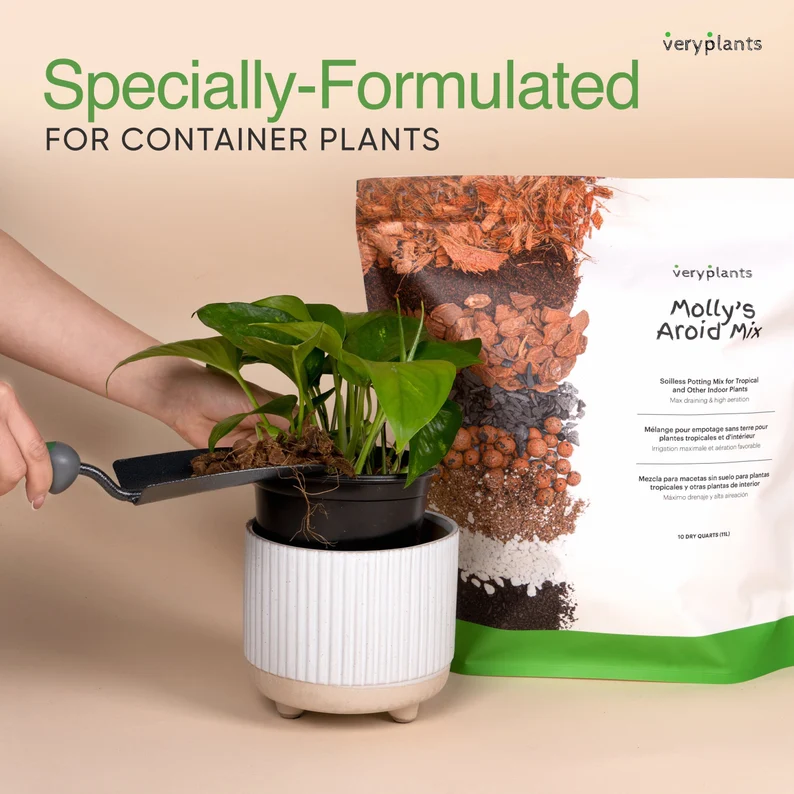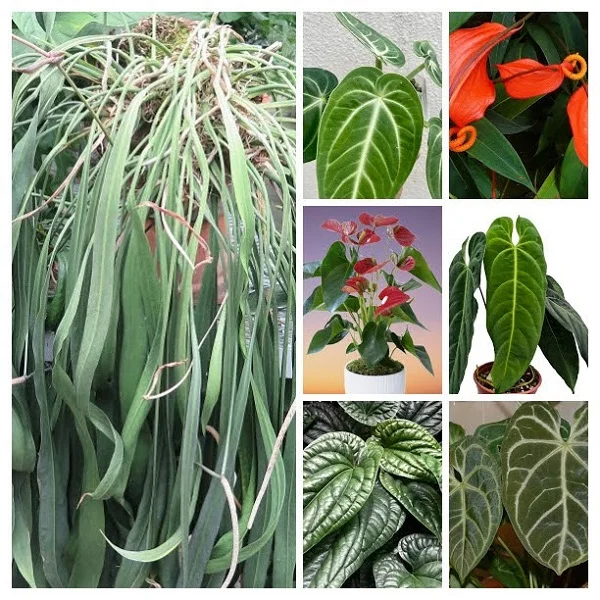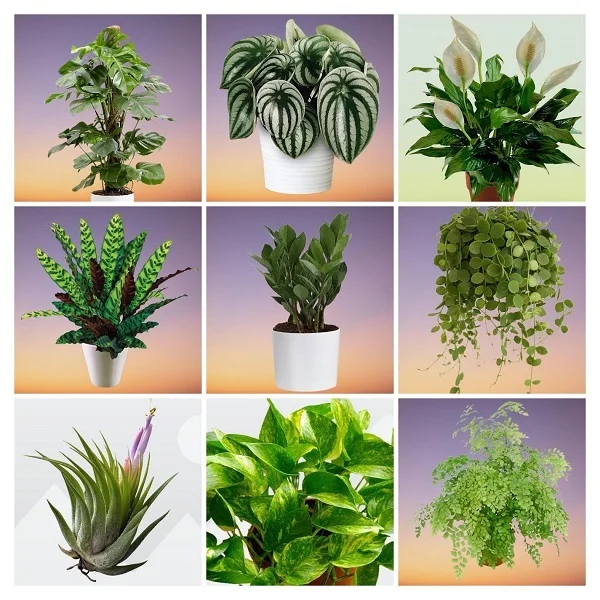Anthurium pallidiflorum (Pale-Flowered Anthurium) Indoor Care, Propagation & Problems
Some links in this post may be affiliate links
Anthurium pallidiflorum grows best in bright indirect light, average warmth, humid conditions and consistently moist, rich, well-drained soil coupled with fortnightly feeding in the growing period.
Anthurium pallidiflorum also called Pale-Flowered Anthurium is one of the rare Anthurium varieties bearing deep-green, pendulous leaves with a prominent, defined light-green rib that runs into a sharp point at the tip.
Pale-Flowered Anthurium is a Strap Leaf Anthurium which bears delicate, pale-colored blooms. The flowers are characterized by long, tubular spathes and a distinctive spadix.
On account of its long, pendulous leaves which can reach up to 20-26 inches long and 6-10 inches wide, Pale-Flowered Anthurium, is one of the best plants for a hanging basket, tabletop or pedestal where it can display the beauty of its leaves.
Anthurium pallidiflorum is similar to Anthurium vittariifolium but in Anthurium vittariifolium the leaves have a less defined midrib and the apex is more broad and less pointed.
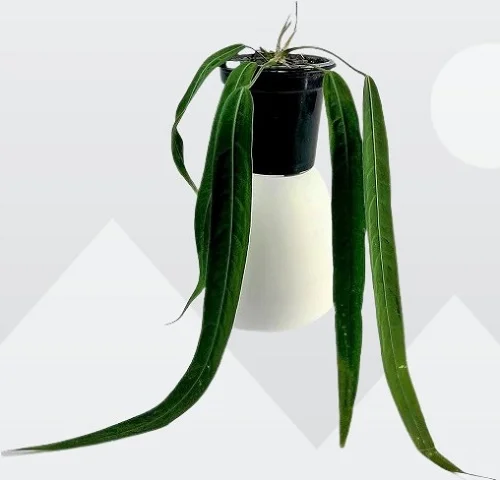
Botanical name: Anthurium pallidiflorum
Family: Araceae
Origin
Anthurium pallidiflorum is a threatened Anthurium variety due to loss of its natural habitat. It is endemic to Ecuador in the subtropical or tropical moist lowland forests where it grows as an epiphyte on trees.
Is Anthurium pallidiflorum toxic to pets?
Yes. Like other Anthuriums, Anthurium pallidiflorum is considered toxic to both humans and pets. Anthuriums contain oxalate crystals which can cause digestive distress, breathing problems and skin irritation. Keep the plants away from children and pets. Always wear gloves when handling these plants and wash your hands thereafter.
Where to Buy
If you are looking to add Anthurium pallidiflorum to your collection, they are available online on Etsy (Link to Etsy).
Anthurium pallidiflorum Care Indoors
To care for Anthurium pallidiflorum indoors, provide bright indirect light, average warmth of 18-270C, humidity of 60-70% and moist, fertile, well-drained soils coupled with fortnightly feeding during the growing season.
Pale-Flowered Anthurium care requires removal of yellow and dead leaves to keep it tidy as well as minimize pest and disease infestations. Repotting is only needed when it is pot-bound. Keep reading for more on the best growing conditions and how to provide them.

Watering
How often should I water Anthurium pallidiflorum?
Water your Anthurium pallidiflorum thoroughly during the growing season (spring and summer) when the top 1-2 inches of soil feels dry to the touch. Keep the soil consistently moist but not soggy to avoid yellowing and rotting.
Decrease watering in the cold season (fall and winter) as growth is minimal to maintain the soil slightly moist. Do not let it dry out completely to prevent wilting and drooping.
Use room temperature water to avoid shocking the plant. Ensure to use chlorine-free water to avoid brown leaf tips. Avoid wetting the foliage to minimize fungal disease infestations.
Ascertain that the pot has a drainage hole and always empty the saucer after watering to prevent the soil from getting soggy as it can result in root-rot and death of the plant.
Light Requirements
Can I grow Anthurium pallidiflorum in low light?
Anthurium pallidiflorum thrives in bright indirect light (dappled light). Position it near a large, brightly-lit window. Keep it away from direct sunshine to prevent scorching; ugly, brown marks on the leaves.
Too little light may slow growth and cause pale, weak foliage. If the natural lighting in your home is not enough, consider instaling grow lights to supplement it.
Turn the pot regularly to ensure that the plant receives light on all sides for uniform growth and avoid lop-sided growth.
Temperature and Humidity
Anthurium pallidiflorum prefers an average warmth of 18-270C. Keep it away from drafts to prevent temperature flactuations as they can cause reduced growth and yellowing.
Above average humidity of 60-70% is ideal for Pale-Flowered Anthurium. If the humidity is below 50%, set the pot on a wet pebble tray or use a humidifier to raise humidity. Ensure that there is good air circulation to prevent fungal infestations.
Fertilizer
Feed Anthurium pallidiflorum with a balanced, water-soluble fertilizer every 4-6 weeks in spring and summer. Stop feeding in fall and winter as growth is minimal at this time and feeding it at this time can result in fertilizer burn.
To get rid of accumulated salts as they can negatively affect growth, regularly run a stream of water through the soil until the water drips through the drainage hole. Allow it to run for a few minutes and repeat the process several times to clear the salts.
Potting Mix
What is the best potting mix for Anthurium pallidiflorum?
The best potting mix for Anthurium pallidiflorum is a well-draining, aerated soil mix to prevent it from getting soggy. A mix of 40% orchid bark (provides structure), 30% peat moss or coco coir (retains moisture), 20% perlite (improves drainage), and 10% charcoal (prevents fungal infections) is ideal for this plant.
Repotting
Repot Anthurium pallidiflorum every 1-2 years at the beginning of the growing season (spring) when it becomes pot-bound. Use a pot one size larger than the current one and fertile, well-drained soil.
Ensure that the pot has a drainage hole to prevent root-rot. On accout of its pendulous leaves, Anthurium pallidiflorum is ideal for a hanging basket. Check out these marcrame plant hanger and self watering pot set on Amazon.
Pruning & Grooming
Pruning Anthurium pallidiflorum involves removal of yellow and dead leaves to maintain the plant neat and to reduce pest and disease infestations.
Cut the leaves at the base of the stem with a sharp sterlized knife or a clean pair of scissors to avoid unnecessary injuries which can result in disease infestations. Cut away any wayward leaves to maintain the shape of the plant.
Gently, damp-wipe the leaves with a soft cloth to get rid of dust and discourage pests and diseases.
Anthurium pallidiflorum Propagation
Anthurium pallidiflorum is propagated at the beginning of the growing season (spring) from offshoots.
Propagating Anthurium pallidiflorum from offshoots
Water the plant thoroughly at least 1 day before to make it easier to divide and also hasten establishment.
Carefully, slip the plant out of its pot and carefully seperate the offshoot from the mother plant. Ensure the offshoot has adequate roots and at least 2 leaves to hasten establishment.
Select a 6 or 8 inch pot that has a drainage hole to prevent the soil from getting soggy as it can lead to rotting.
Fill the pot with loose, well-drained, potting mix and moisten it slightly.
Make a hole in the center of the pot. Ensure that the hole is slightly wider than the base of the offshoot.
Place the offshoot in the previously made hole and lightly firm the soil around the base and maintain it at the same soil level it was in the previous pot.
Wet the soil thoroughly and place the set up in a well-lit, warm place until the new plant is well established after which you can begin routine care.
Related Content: How to Propagate Anthurium Plants by 5 Easy Methods.
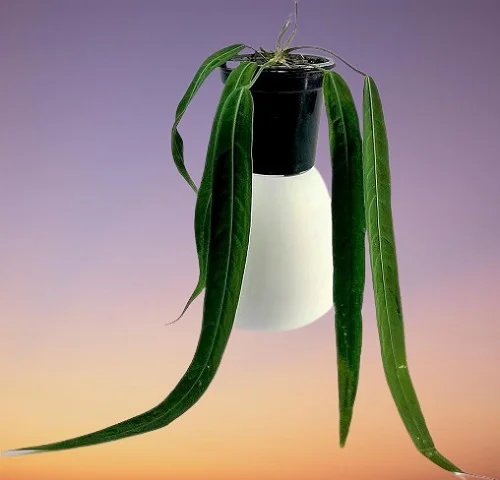
Anthurium pallidiflorum Problems & Remedies
Anthurium pallidiflorum problems are yellow leaves, drooping leaves, brown leaf tips, brown leaves, pests, and diseases among others. Keep reading for more on these problems and how to fix them.
Yellow leaves
Why are the leaves on my Anthurium pallidiflorum turning yellow?
The main causes of yellow leaves on your Anthurium pallidiflorum are inconsistent watering, soggy soil, nutrients deficiency, and drafts.
How to fix it
Inconsistent watering: Do not water on a schedule. Water when the top 1-2 inches of soil feel dry and do not allow the soilball to dry out completely.
Soggy soil: Use a pot with a drainage hole and well-draining soil.
Nutrients deficiency: Feed with a balanced, water soluble fertilizer every 4-6 weeks in spring and summer.
Drafts: Keep the plant away from drafts emanating from windy doors, drafty windows, AC units, heat sources and others.
Drooping leaves
Drooping leaves on Anthurium pallidiflorum is caused by dry air, incorrect watering, temperature stress, direct sunlight, and spider mites infestation.
How to fix it
Dry air: To elevate humidity, set the pot on a wet pebble tray, use a humidifier or group the plants together.
Incorrect watering: Maintain the soil consistently moist in spring and summer and slightly moist in fall and winter. Never allow the soil ball to dry out completely or be soggy.
Temperature stress: Keep the plant away from drafts to maintain temperatures of 16-270C.
Direct sunlight: Keep the plant away from direct sunlight or filter the light with a sheer curtain.
Spider mites infestation: Regularly inspect the plant and take timely control measures for these pests.
Brown leaf tips
Brown leaf tips on Anthurium pallidiflorum are due to low humidity, underwatering, soggy soil, and salts buildup.
How to fix it
Low humidity: Set the pot on a wet pebble tray or use a cool mist humidifier to increase humidity.
Underwatering: Do not allow the soil to dry out completely; water when the top 1-2 inches of soil dry out.
Soggy soil: Use well-draining soil and a pot that has a drainage hole.
Salts buildup: Regularly, flush out accumulated salts from the soil from the soil by running a stream of water through the soil until it drains through the drainage hole.
Brown leaves
Some of the causes of brown leaves on Anthurium pallidiflorum are direct sunlight, overwatering, soggy soil and extreme temperatures.
How to fix it
Direct sunlight: Move the plant to a more shaded place or use a curtain to filter the sunlight.
Overwatering: Water when the top 1-2 inches of soil dry out to avoid overwatering. Do not water on a schedule.
Soggy soil: Ensure the pot has a drainage hole and the soil drains easily.
Extreme temperatures: Keep the plant from windy doors, AC units, heat vents, stoves, drafty windows and other drafty conditions.
Pests
Common pests on Anthurium pallidiflorum are spider mites, aphids and mealybugs.
How to fix it
- Check underneath the leaves regularly for these pests and take timely control measures.
- Isolate the affected plant to prevent spread to other plants and treat it with neem oil or insecticidal soap as per the manufacturer's instructions.
- Damp-wipe the leaves regularly with a soft cloth to discourage the pests.
- Keep the plant well pruned to reduce the hiding and breeding places for these pests.
Diseases
Anthurium pallidiflorum is prone to root-rot disease which is more prevalent in soggy soil. It is characterized by yellowing and wilting of the leaves which is rapidly followed by browning and plant collapse.
How to fix it
- Carefully slip the plant out of its pot and inspect the roots.
- Trim brown-black, mushy roots and treat the healthy roots with a copper-based fungicidal solution as recommended on the label.
- Disinfect the pot with the fungicidal solution or use a fresh pot to repot the plant in fresh, well-draining soil.
- Do not water the plant immediately and keep it dry for 5-7 days before you can resume watering.
- Use a pot with a drainage hole and well-draining soil at all times to prevent the soil from soggy.
- Lessen watering in fall and winter as growth is minimal at this time; keep the soil slightly moist.
Related Content: 8 Common Anthurium Problems and How to Fix Them.
Conclusion
Anthurium pallidiflorum is a rare, stunning houseplant with long, velvety leaves that require high humidity, bright indirect light, and proper watering to thrive. By using well-draining soil, fertilizing appropriately, and managing pests, you can keep your plant healthy and vibrant.
You liked it? Share on social media.
Related Content
Amazon Associates Disclosure
Homeplantsguide.com is a participant in the Amazon Services LLC Associates Program, an affiliate advertising program designed to provide a means for sites to earn advertising fees by advertising and linking to amazon.com.


